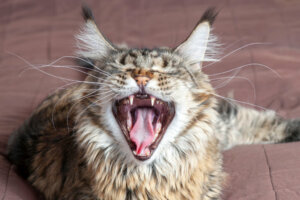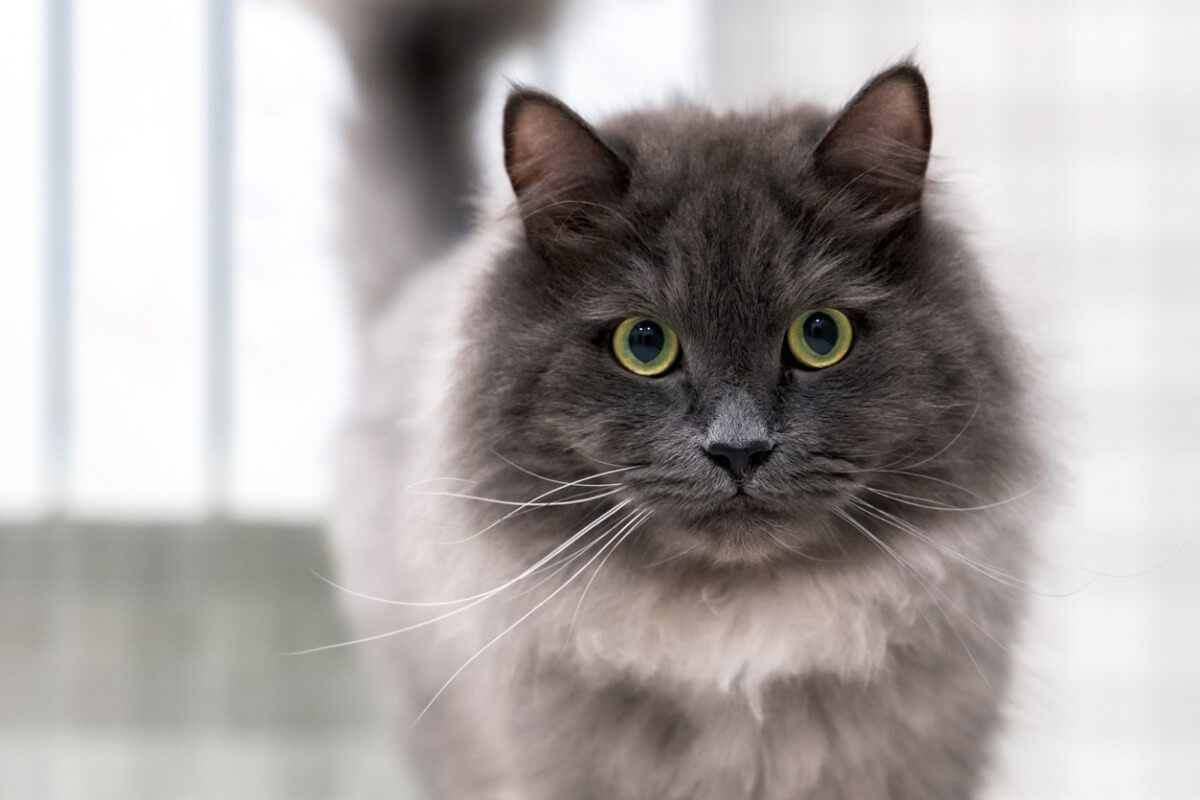4 Myths about Cat Whiskers


Reviewed and approved by the biologist Samuel Sanchez
Just as it’s said that black cats bring bad luck, that their purr shows that they’re happy, or that they should be given cow’s milk, there are also several myths surrounding cat whiskers.
A cat’s whiskers are deeply embedded in the skin, surrounded by nerves, sensory cells and muscles, connected to their locomotor and nervous systems. In this way, they send sensory messages to their brain and become tireless explorers. Here you can learn 4 myths about cat whiskers.
1. They’re to help a cat find their way
Whiskers are very sensitive to vibrations and changes in the environment and, therefore, are of essential importance for their spatial orientation along with the rest of the senses, according to the ethologist Rosana Álvarez. However, they’re not just for location.
Whiskers are also called vibrissae, because, through them, cats perceive the air and nearby objects. In this way – so says the newspaper El Comercio – felines can detect the size and location of the elements around them.
Likewise, these structures help cats with their near vision, with their night vision, to walk in a straight line, to calculate the distances when they jump, and to distinguish the size and location of their prey.
Whatever the case, whiskers aren’t only used to measure the width of the places they move around in, or the proximity of objects. In addition to all these functions, these help determine the animal’s mood.
If the cat is relaxed, its whiskers will be slightly to one side; if they’re happy or curious, their whiskers will be extended. As they become more interested in something, these structures spread out in front of their nose, and if they’re scared, irritated, or ill, their whiskers will roll back.

2. The whiskers are only on their faces
Whiskers are multifunctional tactile hairs — thicker and longer than the cat’s fur — located on the eyes, ears, jaw, and forelegs. They’re very sensitive sensory hairs that fulfill the function of a useful radar. So, they’re not only facial structures.
3. You can cut cat whiskers
Imagine that you’re a feline, and that all the characteristics mentioned suddenly cease to exist in your life. Cat whiskers are essential for their daily lives, and for their location and comfort in an environment. For these reasons, never clip or pull a cat’s whiskers, as they can become disoriented and scared without them.
In addition, these structures have many nerve endings and if you cut them, the cat will be in pain. On the other hand, if, for some reason, your pet loses its whiskers, they’ll grow back in a month or two – if they still have a healthy hair bulb.
4. A cat loses balance without its whiskers
As mentioned above, cats use their whiskers as sensors or radars, but not for balance. Balance in the cat is a sophisticated circuit formed by the muscular, tactile and visual systems.
If the cat were to lose its whiskers, it would have to rely much more on these other senses to explore the territory, see up close and at night, hunt, and express its emotions. However, this doesn’t mean that it would lose its ability to move and balance completely.

As you can see, cats whiskers are necessary and there are many characteristics that you should take into account regarding them as an owner. In this way, you’ll take better care of your feline and avoid situations that could harm it or make it uncomfortable.
Just as it’s said that black cats bring bad luck, that their purr shows that they’re happy, or that they should be given cow’s milk, there are also several myths surrounding cat whiskers.
A cat’s whiskers are deeply embedded in the skin, surrounded by nerves, sensory cells and muscles, connected to their locomotor and nervous systems. In this way, they send sensory messages to their brain and become tireless explorers. Here you can learn 4 myths about cat whiskers.
1. They’re to help a cat find their way
Whiskers are very sensitive to vibrations and changes in the environment and, therefore, are of essential importance for their spatial orientation along with the rest of the senses, according to the ethologist Rosana Álvarez. However, they’re not just for location.
Whiskers are also called vibrissae, because, through them, cats perceive the air and nearby objects. In this way – so says the newspaper El Comercio – felines can detect the size and location of the elements around them.
Likewise, these structures help cats with their near vision, with their night vision, to walk in a straight line, to calculate the distances when they jump, and to distinguish the size and location of their prey.
Whatever the case, whiskers aren’t only used to measure the width of the places they move around in, or the proximity of objects. In addition to all these functions, these help determine the animal’s mood.
If the cat is relaxed, its whiskers will be slightly to one side; if they’re happy or curious, their whiskers will be extended. As they become more interested in something, these structures spread out in front of their nose, and if they’re scared, irritated, or ill, their whiskers will roll back.

2. The whiskers are only on their faces
Whiskers are multifunctional tactile hairs — thicker and longer than the cat’s fur — located on the eyes, ears, jaw, and forelegs. They’re very sensitive sensory hairs that fulfill the function of a useful radar. So, they’re not only facial structures.
3. You can cut cat whiskers
Imagine that you’re a feline, and that all the characteristics mentioned suddenly cease to exist in your life. Cat whiskers are essential for their daily lives, and for their location and comfort in an environment. For these reasons, never clip or pull a cat’s whiskers, as they can become disoriented and scared without them.
In addition, these structures have many nerve endings and if you cut them, the cat will be in pain. On the other hand, if, for some reason, your pet loses its whiskers, they’ll grow back in a month or two – if they still have a healthy hair bulb.
4. A cat loses balance without its whiskers
As mentioned above, cats use their whiskers as sensors or radars, but not for balance. Balance in the cat is a sophisticated circuit formed by the muscular, tactile and visual systems.
If the cat were to lose its whiskers, it would have to rely much more on these other senses to explore the territory, see up close and at night, hunt, and express its emotions. However, this doesn’t mean that it would lose its ability to move and balance completely.

As you can see, cats whiskers are necessary and there are many characteristics that you should take into account regarding them as an owner. In this way, you’ll take better care of your feline and avoid situations that could harm it or make it uncomfortable.
All cited sources were thoroughly reviewed by our team to ensure their quality, reliability, currency, and validity. The bibliography of this article was considered reliable and of academic or scientific accuracy.
Álvarez R. Etología felina: guía básica sobre el comportamiento del gato. [Internet]. España: Amazing Books S.L.; 2018 [consultado el 7 de abril de 2021]. Disponible en: https://books.google.es/books?hl=en&lr=&id=khrLDwAAQBAJ&oi=fnd&pg=PT7&dq=etolog%C3%ADa+gatos&ots=hc9R4rmHKR&sig=Xy7wSL8Mbdiq_-WSX5O7Os1ego8#v=onepage&q&f=false
Mascotas: gatos. Tu hogar [Internet] 2020 [consultado el 3 de mayo de 2021]. Disponible en: https://www.bibliotecadigitaldebogota.gov.co/resources/3267315/
Purina. ¿Para qué sirven los bigotes de los gatos? [Internet]. Purina. [consultado el 3 de mayo de 2021]. Disponible en: https://www.purina-latam.com/mx/purina/nota/gatos/para-que-sirven-los-bigotes-de-los-gatos#:~:text=Los%20bigotes%20de%20tu%20gato,%C3%B3rgano%20sensorial%20conocido%20como%20propioceptor
Yrigoyen L. Cuidado con cortarle los bigotes a tu gato [Internet]. El Comercio: 22 de enero de 2016 [consultado el 3 de mayo de 2021]. Disponible en: https://elcomercio.pe/wuf/consultorio/cuidado-cortarle-bigotes-gato-274889-noticia/?ref=ecr
This text is provided for informational purposes only and does not replace consultation with a professional. If in doubt, consult your specialist.








